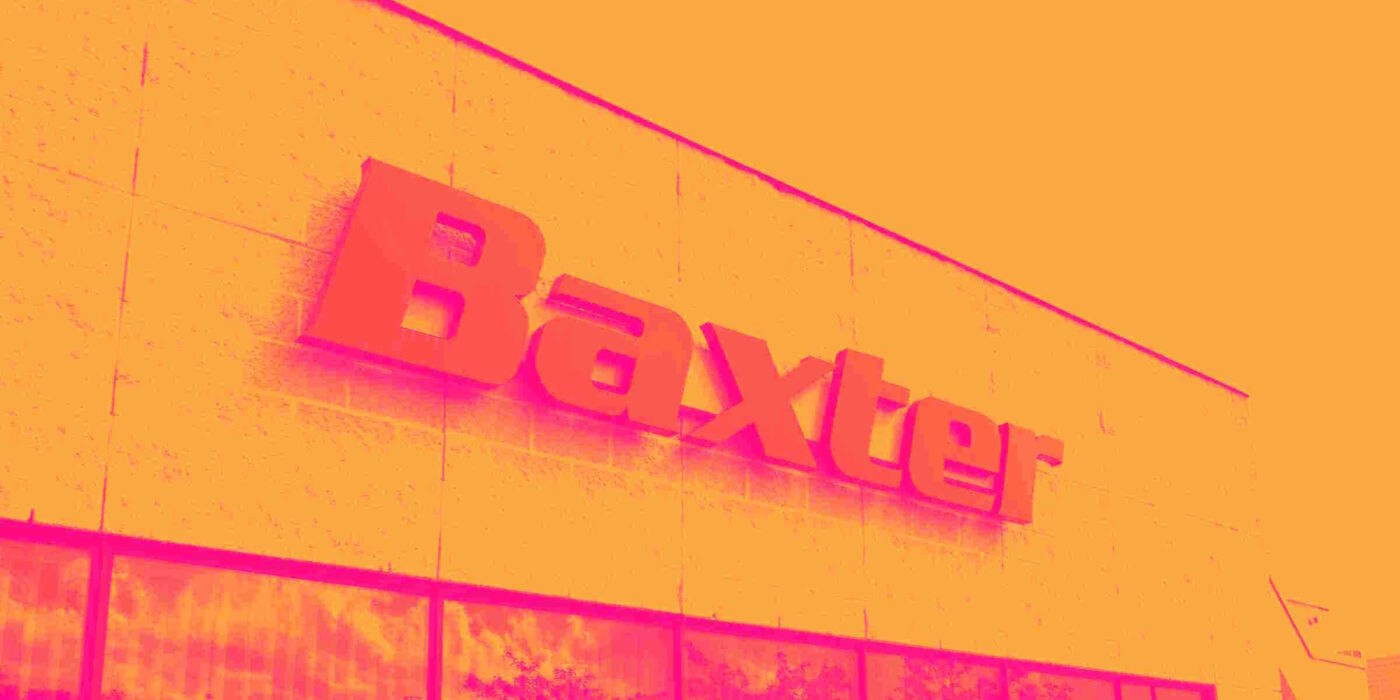
Healthcare company Baxter International (NYSE: BAX) beat Wall Street’s revenue expectations in Q1 CY2025, with sales up 5.4% year on year to $2.63 billion. On the other hand, next quarter’s revenue guidance of $2.82 billion was less impressive, coming in 0.5% below analysts’ estimates. Its non-GAAP profit of $0.55 per share was 13.8% above analysts’ consensus estimates.
Is now the time to buy Baxter? Find out by accessing our full research report, it’s free.
Baxter (BAX) Q1 CY2025 Highlights:
- Revenue: $2.63 billion vs analyst estimates of $2.58 billion (5.4% year-on-year growth, 1.9% beat)
- Adjusted EPS: $0.55 vs analyst estimates of $0.48 (13.8% beat)
- Adjusted Operating Income: $392 million vs analyst estimates of $388.4 million (14.9% margin, 0.9% beat)
- Revenue Guidance for Q2 CY2025 is $2.82 billion at the midpoint, below analyst estimates of $2.83 billion
- Management slightly raised its full-year Adjusted EPS guidance to $2.51 at the midpoint
- Operating Margin: 2.2%, down from 4.6% in the same quarter last year
- Constant Currency Revenue rose 5% year on year (2% in the same quarter last year)
- Market Capitalization: $15.99 billion
“Our solid performance in the first quarter of 2025 reflects the ongoing impact of our transformation journey,” said Brent Shafer, chair and interim chief executive officer.
Company Overview
With a history dating back to 1931 and products used in over 100 countries, Baxter International (NYSE: BAX) provides essential healthcare products including dialysis therapies, IV solutions, infusion systems, surgical products, and patient monitoring technologies to hospitals and clinics worldwide.
Sales Growth
A company’s long-term sales performance can indicate its overall quality. Any business can have short-term success, but a top-tier one grows for years. Over the last five years, Baxter’s demand was weak and its revenue declined by 1.3% per year. This wasn’t a great result and suggests it’s a low quality business.
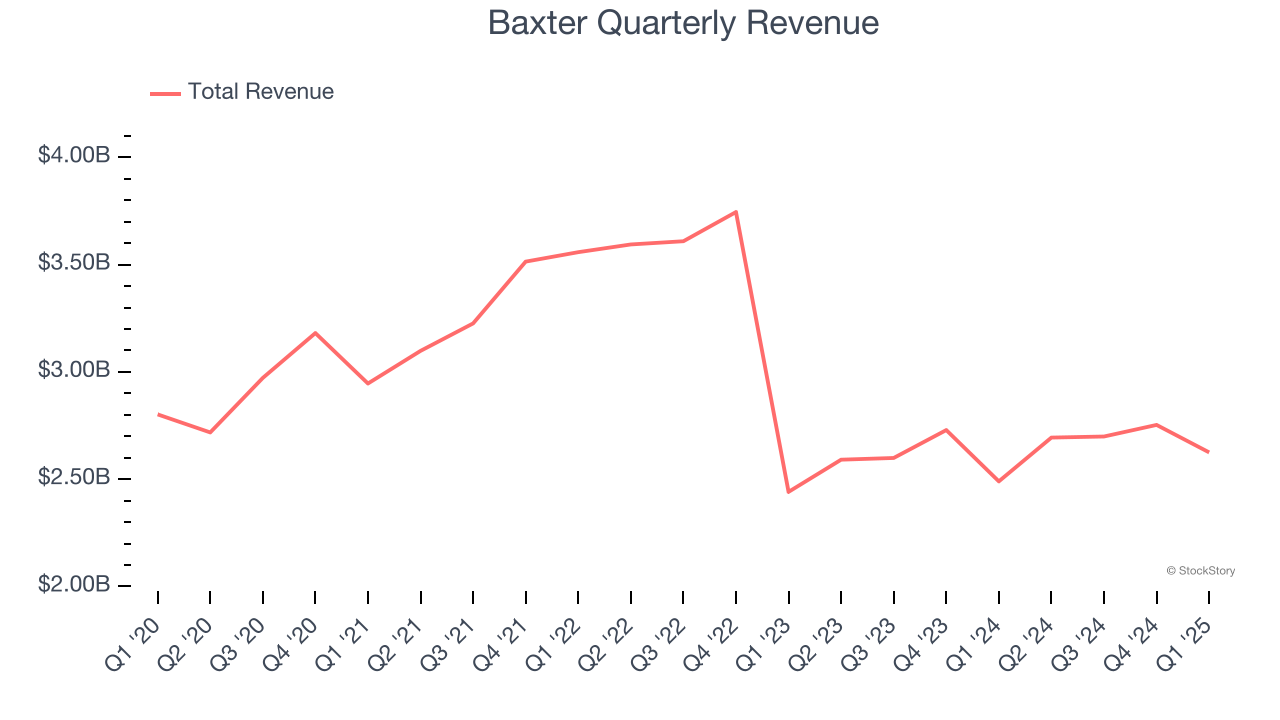
We at StockStory place the most emphasis on long-term growth, but within healthcare, a half-decade historical view may miss recent innovations or disruptive industry trends. Baxter’s recent performance shows its demand remained suppressed as its revenue has declined by 10.3% annually over the last two years. 
We can better understand the company’s sales dynamics by analyzing its constant currency revenue, which excludes currency movements that are outside their control and not indicative of demand. Over the last two years, its constant currency sales averaged 3.9% year-on-year growth. Because this number is better than its normal revenue growth, we can see that foreign exchange rates have been a headwind for Baxter. 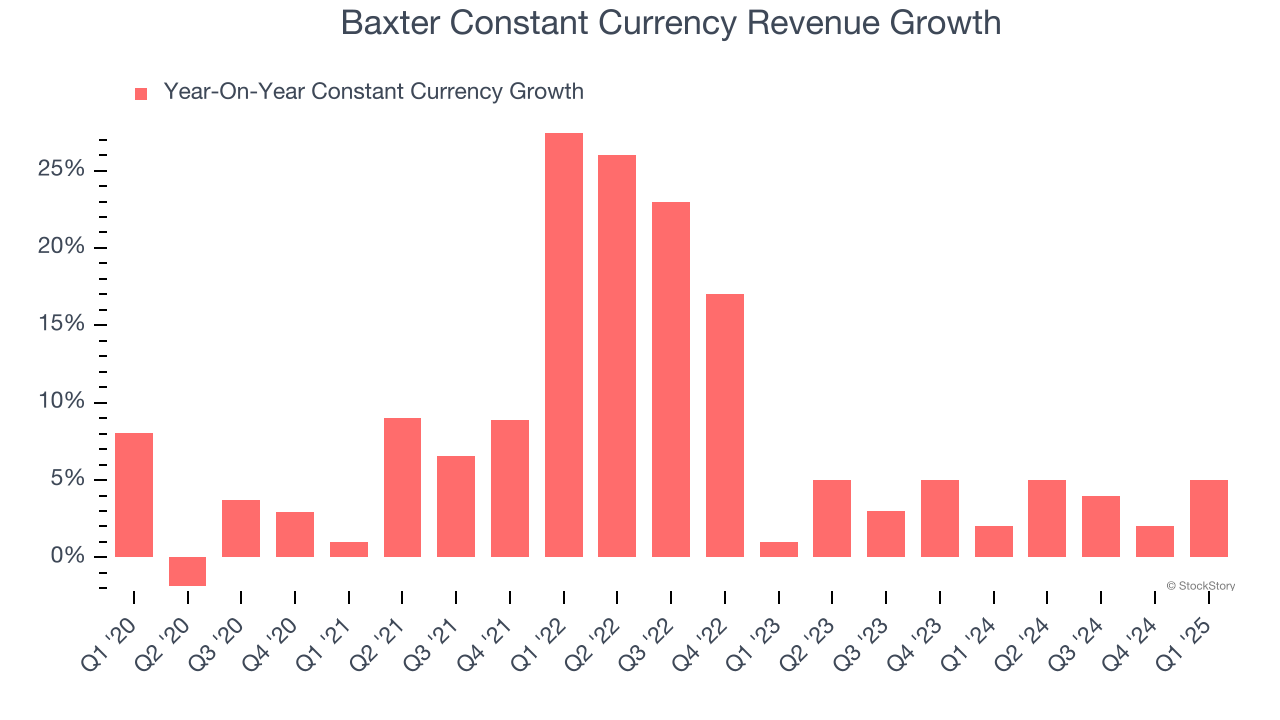
This quarter, Baxter reported year-on-year revenue growth of 5.4%, and its $2.63 billion of revenue exceeded Wall Street’s estimates by 1.9%. Company management is currently guiding for a 4.5% year-on-year increase in sales next quarter.
Looking further ahead, sell-side analysts expect revenue to grow 5.2% over the next 12 months, an improvement versus the last two years. This projection is above the sector average and implies its newer products and services will fuel better top-line performance.
Today’s young investors won’t have read the timeless lessons in Gorilla Game: Picking Winners In High Technology because it was written more than 20 years ago when Microsoft and Apple were first establishing their supremacy. But if we apply the same principles, then enterprise software stocks leveraging their own generative AI capabilities may well be the Gorillas of the future. So, in that spirit, we are excited to present our Special Free Report on a profitable, fast-growing enterprise software stock that is already riding the automation wave and looking to catch the generative AI next.
Adjusted Operating Margin
Adjusted operating margin is an important measure of profitability as it shows the portion of revenue left after accounting for all core expenses – everything from the cost of goods sold to advertising and wages. It’s also useful for comparing profitability across companies because it excludes non-recurring expenses, interest on debt, and taxes.
Baxter has managed its cost base well over the last five years. It demonstrated solid profitability for a healthcare business, producing an average adjusted operating margin of 16.1%.
Analyzing the trend in its profitability, Baxter’s adjusted operating margin decreased by 3 percentage points over the last five years. A silver lining is that on a two-year basis, its margin has stabilized. Still, shareholders will want to see Baxter become more profitable in the future.
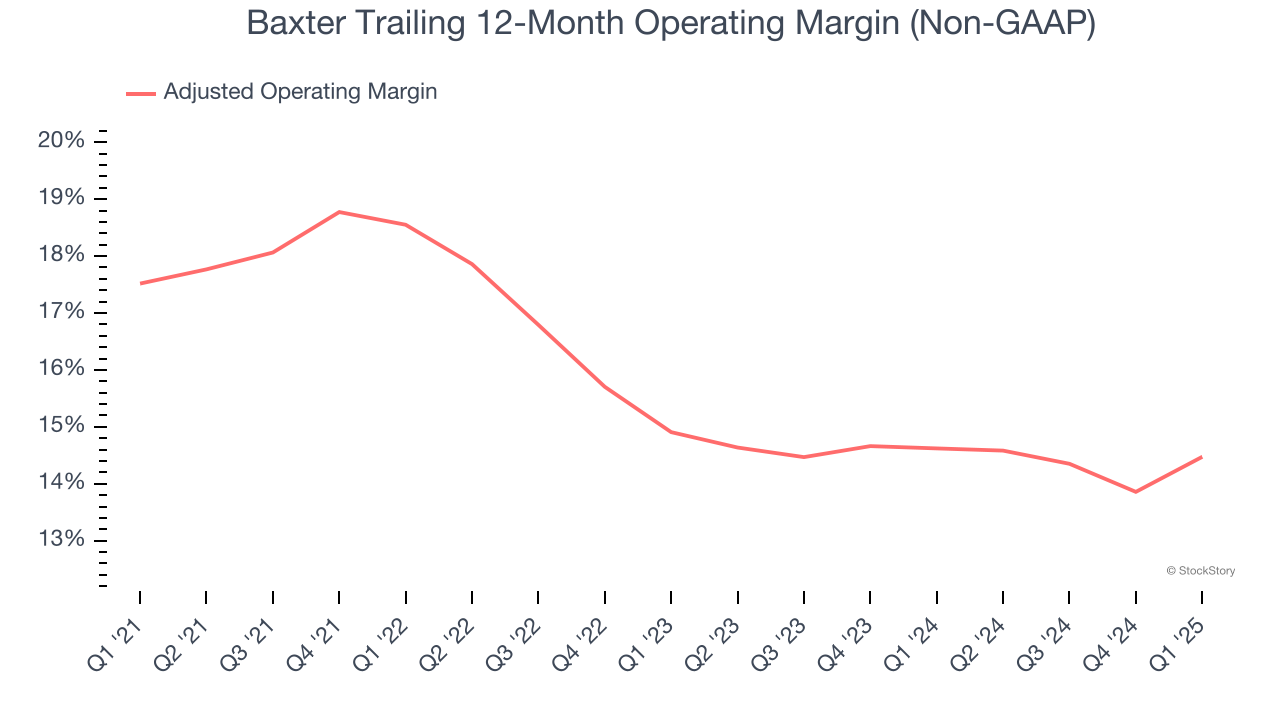
In Q1, Baxter generated an adjusted operating profit margin of 14.9%, up 2.6 percentage points year on year. This increase was a welcome development and shows it was more efficient.
Earnings Per Share
We track the long-term change in earnings per share (EPS) for the same reason as long-term revenue growth. Compared to revenue, however, EPS highlights whether a company’s growth is profitable.
Sadly for Baxter, its EPS declined by 9.3% annually over the last five years, more than its revenue. This tells us the company struggled because its fixed cost base made it difficult to adjust to shrinking demand.
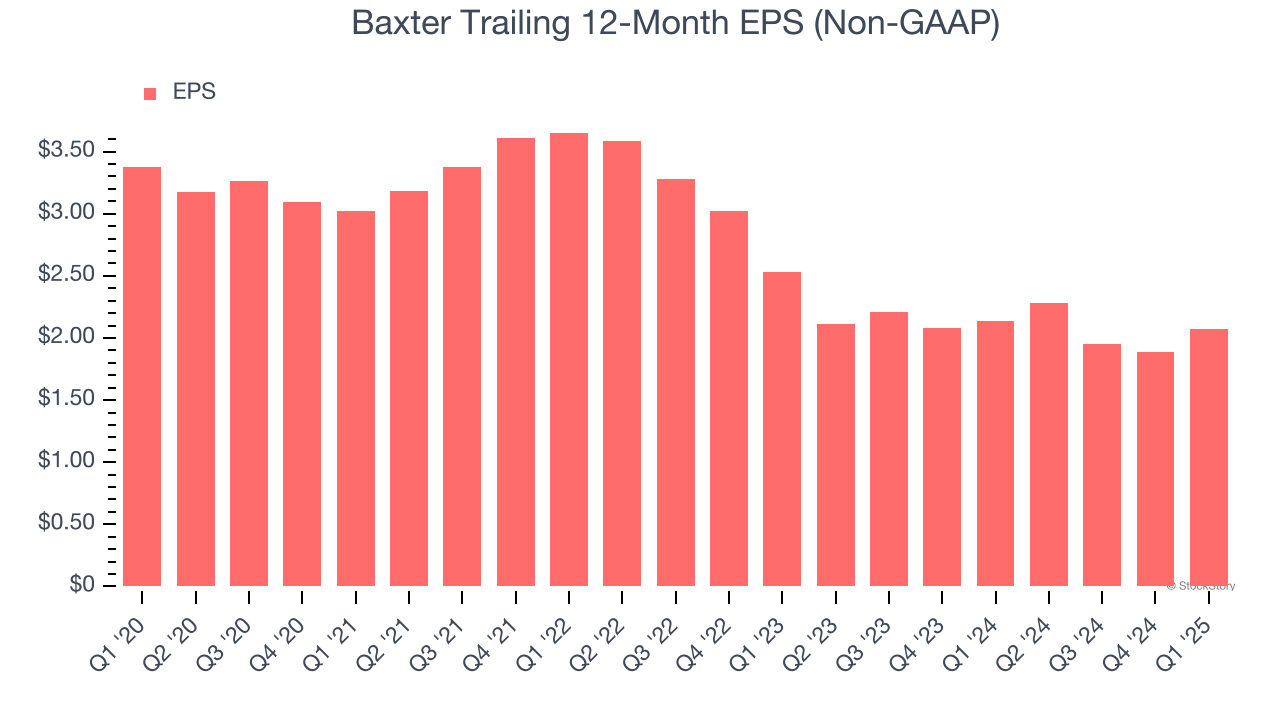
Diving into the nuances of Baxter’s earnings can give us a better understanding of its performance. As we mentioned earlier, Baxter’s adjusted operating margin improved this quarter but declined by 3 percentage points over the last five years. This was the most relevant factor (aside from the revenue impact) behind its lower earnings; taxes and interest expenses can also affect EPS but don’t tell us as much about a company’s fundamentals.
In Q1, Baxter reported EPS at $0.55, up from $0.36 in the same quarter last year. This print easily cleared analysts’ estimates, and shareholders should be content with the results. Over the next 12 months, Wall Street expects Baxter’s full-year EPS of $2.08 to grow 21.4%.
Key Takeaways from Baxter’s Q1 Results
We were impressed by how significantly Baxter blew past analysts’ constant currency revenue expectations this quarter. We were also glad its EPS outperformed Wall Street’s estimates. On the other hand, its revenue guidance for next quarter slightly missed. Overall, we think this was still a solid quarter with some key areas of upside. The stock traded up 1.5% to $31.63 immediately after reporting.
Sure, Baxter had a solid quarter, but if we look at the bigger picture, is this stock a buy? When making that decision, it’s important to consider its valuation, business qualities, as well as what has happened in the latest quarter. We cover that in our actionable full research report which you can read here, it’s free.


